ENG 130 (ENG130)
Lees-Mcrae College
Page 2 out of 28 results
Sort by

-
LETRS Unit 2 Session 3.
- Exam (elaborations) • 1 pages • 2022
- Available in package deal
-
- $9.49
- + learn more
1. Phonemic awareness instruction for young learners is most beneficial when linked with phonics instruction. o true o false 2. The inventory of phonemes used in Spanish is nearly identical to that used in English. o true o false 3. A third-grade teacher wants to determine whether any of her students are at risk for reading failure. She should use a screening measure that assesses which of the following? o a. their ability to segment phonemes o b. their ability to manipulate phonemes...
LETRS Unit 1 Sessions 1-8 Assessment/Quizzes 2022.
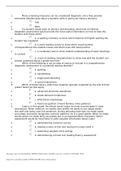
-
LETRS Unit 2 Session 1
- Exam (elaborations) • 1 pages • 2022
- Available in package deal
-
- $9.49
- + learn more
1. Many screening measures can be considered diagnostic since they provide extremely detailed data about a students skills in particular literacy domains. o true o false 2. If a student needs work on phonics and decoding, what kind of informal diagnostic assessment would provide the most useful information on how to help this student with these skills? o a. a spelling inventory to show which features of English spelling the student has mastered o b. a word-reading survey to show which s...

-
LETRS Unit 2 Session 2
- Exam (elaborations) • 1 pages • 2022
- Available in package deal
-
- $9.49
- + learn more
1. Even after first grade, skills such as phoneme segmentation and blending of single-syllable words without consonant blends are good predictors of reading ability. o true o false 2. Students’ ability to acquire phonemic awareness is not dependent on which of the following factors? o a. general language development and listening abilities o b. word comprehension o c. familiarity with vocabulary used in tasks o d. the amount of practice received 3. Which of these tasks could a studen...
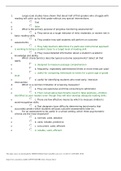
-
LETRS Unit 1 Session 7.
- Exam (elaborations) • 1 pages • 2022
- Available in package deal
-
- $11.49
- + learn more
1. Large-scale studies have shown that about half of first-graders who struggle with reading will catch up by third grade without any special interventions. o true o false 2. What is the primary purpose of progress-monitoring assessments? o a. They serve as a rough indicator of mild, moderate, or severe risk in basic reading skills. o b. They predict how well students will perform on outcome assessments. o c. They help teachers determine if a particular instructional approach is workin...
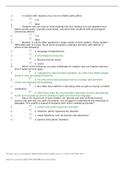
-
LETRS Unit 1 Session 6.
- Exam (elaborations) • 1 pages • 2022
- Available in package deal
-
- $9.49
- + learn more
1. A student with dyslexia may also be intellectually gifted. o true o false 2. Students who are slow at word reading and text reading, but can segment and blend sounds orally, typically have better outcomes than students with phonological processing deficits. o true o false 3. Dyslexic is a term often applied to a large subset of poor readers. These readers’ difficulties with accurate, fluent word recognition originate primarily with deficits in which of the following? o a. languag...
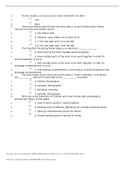
-
LETRS Unit 1 Session 3.
- Exam (elaborations) • 1 pages • 2022
- Available in package deal
-
- $10.49
- + learn more
1. During reading, our eyes process each word letter by letter. o true o false 2. How many letters does the eye normally take in at each fixation point before moving on to the next fixation point? o a. five letters total o b. however many letters are in each word o c. 7–9 to the right and 3–4 to the left o d. 3–4 to the right and 7–9 to the left 3. The Four-Part Processing Model helps us understand _________________. o a. which part of the brain handles word recognition o b. h...

-
LETRS Unit 1 Session 5
- Exam (elaborations) • 1 pages • 2022
- Available in package deal
-
- $9.49
- 1x sold
- + learn more
1. What skill is most important for a student just learning to read? o a. quick identification of sight words o b. recognition of letter names o c. understanding of prefixes and suffixes o d. accurate decoding 2. A child sees the word savanna and sounds it out accurately. Which of Ehri’s phases is she in? o a. prealphabetic stage o b. early alphabetic stage o c. later alphabetic stage o d. consolidated alphabetic stage 3. A child who responds “Bow-wow!” when asked, “What is th...
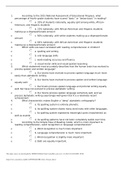
-
LETRS Unit 1 Session 1
- Exam (elaborations) • 1 pages • 2022
- Available in package deal
-
- $9.49
- + learn more
According to the 2015 National Assessment of Educational Progress, what percentage of fourth-grade students have scored “basic” or “below basic” in reading? o a. 33% of students nationally, equally split among white, AfricanAmerican, and Hispanic students o b. 23% nationally, with African-American and Hispanic students making up a disproportionate amount o c. 50% nationally, with white students making up a disproportionate amount o d. 64% nationally, with African-American and Hisp...
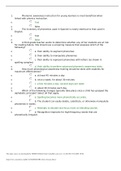
-
LETRS Unit 2 Session 3.docx (complete)Practice Tests & Exam Prep 2022/2023
- Exam (elaborations) • 1 pages • 2022
-
Available in package deal
-
- $9.99
- + learn more
Phonemic awareness instruction for young learners is most beneficial when linked with phonics instruction. o true o false 2. The inventory of phonemes used in Spanish is nearly identical to that used in English. o true o false 3. A third-grade teacher wants to determine whether any of her students are at risk for reading failure. She should use a screening measure that assesses which of the following? o a. their ability to segment phonemes o b. their ability to manipulate phonemes o...

Do you wonder why so many students wear nice clothes, have money to spare and enjoy tons of free time? Well, they sell on Stuvia! Imagine your study notes being downloaded a dozen times for $15 each. Every. Single. Day. Discover all about earning on Stuvia


